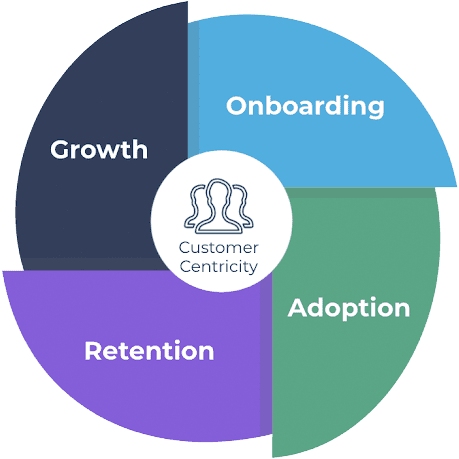The SaaS industry has never been so competitive. As the pressure to perform piles on product leaders and managers, there’s a way to release the tension, drive product growth, and tap into a growth plan that feeds off itself.
We’re talking about the product-led flywheel. And assembling your own product-led flywheel may be easier than you realize. With a few tips and tricks guiding the way, you can create your own product-led flywheel that starts pumping out growth faster and faster.
What is a product-led flywheel?
The product-led flywheel is a framework you can use to encourage product-led growth. It challenges the traditional sales and marketing funnel, where you cast a wide net and hope new leads will swirl down conversion paths to a sale. Instead, the product-led flywheel focuses on the user experience at different stages of the user’s journey. It works like a spinning spool, picking up speed and promoting more growth as you improve at each stage.
On the inner circle of your flywheel, visualize the different segments of your users based on their stage of their product journey. Here are some common examples:
- Product qualified leads
- Customers
- Active customers
- Loyal customers
At the same time, imagine another spinning circle on the outer layer of your flywheel. This wheel represents the different stages of product growth:
- Onboarding
- Adoption
- Retention
- Growth

Unlike traditional funnels, the flywheel lets you address different user segments at different growth stages—spinning faster and promoting more growth as you enhance different instances of the user’s experience.
What are the benefits of a product-led flywheel?
There’s a pile of benefits you gain from using a product-led flywheel. Here are a few:
It’s a better fit in the modern SaaS market.
The traditional sales and marketing funnel was set up for companies that needed to attract a variety of new customers and land one-off sales. The modern SaaS market depends on recurring revenue to be successful. SaaS companies now need to excel within subscription, freemium, or more product-focused models. The flywheel makes it easier to prove product value right away and keep users buying from you on an ongoing basis.
It leads to higher NDR.
To be successful in the product world, you need to perfect your long game. That means shifting your focus from quick wins or sales to net dollar retention (NDR). The flywheel makes it easier to up NDR by delivering stellar experiences to both new and existing users.
It speeds up over time.
Once it’s in place, your flywheel will become more effective at producing growth as you go because your growth stages feed on one another. Ultimately, that lifts work off of you and drives faster growth.
How can you propel your flywheel and supercharge your product?
Ready to kick your product-led flywheel into high gear? Here are some keys to jump-starting a successful flywheel and propelling growth:
Understand the customer experience.
Your users’ experience is the bedrock supporting your product-led growth plans. And it’s for good reason. One study found 84% of companies that made an effort to improve customer experience saw revenue growth. Whenever you can, try to keep your finger on the pulse of your users’ experience and make adjustments through tools such as in-product analytics, in-product engagements, and surveys.
Take a smarter approach to segmentation.
The better you understand your users, the easier it is to satisfy their needs. You can start by using surveys and customer feedback loops to develop different user segments. But you can also drill even deeper through behavioral segmentation. From there, identify your different users’ pain points as well as their objectives. Then create a plan to eliminate as many pain points as possible and build a bridge from each user to their objectives as quickly as possible.
Target product qualified leads.
An important part of moving from a funnel to a product-led flywheel is shifting your focus to a more intentional set of leads. When you focus on product qualified leads, you’ll be targeting people who have already proven that they’re interested in using your product or making a purchase. This approach to lead generation lowers acquisition costs and helps you avoid wasting your time and energy pursuing people who aren’t interested in your product.
Make onboarding easy.
If you want to spark ongoing product growth, you need to reduce time to value (TTV). That means making your onboarding process as seamless—and thorough—as possible. To improve onboarding, dive into your in-product analytics, identify any friction points holding back new users, and carve out a plan to cut out friction during the sign-up process. In many cases, you’ll find you can dramatically boost onboarding by adding educational materials, strategic in-app engagements, checklists, or guides.
Power your plans with analytics.
In-product analytics provide the fuel to power your product-led growth flywheel. As we mentioned earlier, you can use analytics to understand your users on a deep level and identify the enhancements that will provide the biggest bang for your buck. Additionally, you can use analytics to prove to stakeholders that your flywheel is working, and you can lean on metrics as you chart your product roadmap decisions.
Become a product-led success master.
Perfecting your product-led flywheel will lay the groundwork for faster growth and a user-first product. But when it comes to mastering product-led growth, your flywheel only scratches the surface.
Read our free guide, “Product Led Success: Professional’s Handbook,” for an in-depth look at product-led growth and a breakdown of what you can do to drive ongoing growth through your product.

